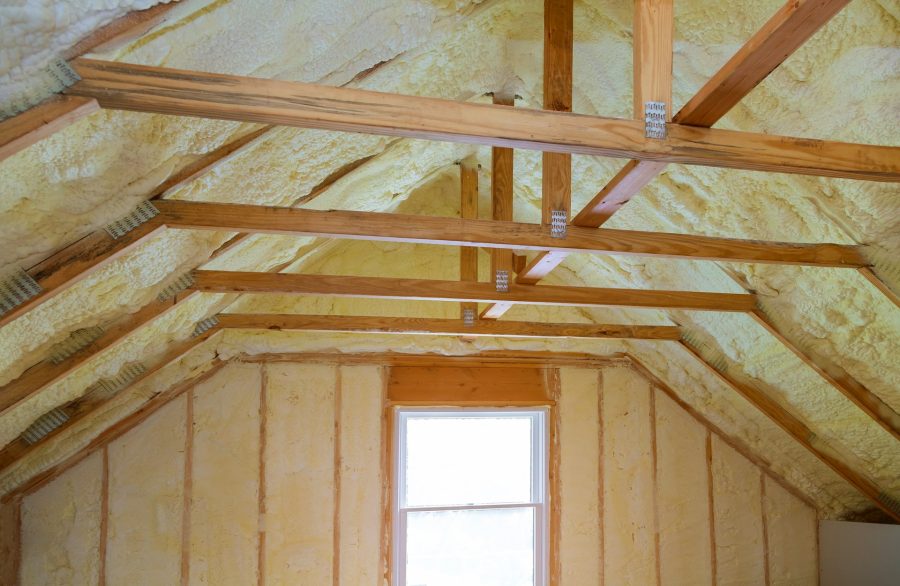Insulating your home for the colder months
Proper home insulation is crucial, especially in the UK, where the weather can be unpredictable and chilly. Insulation acts as a protective barrier, preventing heat loss and cold air infiltration, ultimately keeping your home warm and cosy during the winter months. By investing in insulation, you can significantly reduce your heating bills and create a comfortable living environment for you and your family.
One of the main benefits of home insulation is its ability to improve energy efficiency. Insulated homes retain heat better, meaning you won’t have to rely as heavily on your heating system to maintain a comfortable temperature. This, in turn, reduces your energy consumption and lowers your carbon footprint, contributing to a greener and more sustainable future.
Furthermore, proper insulation also helps to regulate the temperature inside your home, providing a consistent and comfortable environment throughout the year. It prevents heat from escaping during the winter and keeps the heat out during the summer, ensuring that your home remains pleasant no matter the season. Insulation also helps to minimise condensation and dampness, which can lead to mould growth and damage to your property.
In summary, home insulation is essential in the UK to combat the cold weather, reduce energy consumption, and create a comfortable living space. By insulating your home, you can enjoy the benefits of lower heating bills, improved energy efficiency, and a more sustainable lifestyle.
Understanding the different types of insulation materials
When it comes to insulation materials, there are several options available for British homeowners. Each material has its own unique properties and benefits, so it’s important to understand the differences to make an informed decision for your home.
One common type of insulation material is fiberglass. Fiberglass insulation is made from tiny glass fibres and is known for its excellent thermal performance. It is relatively affordable and easy to install, making it a popular choice for homeowners. Fiberglass insulation comes in rolls or batts and can be used in various areas of your home, including walls, ceilings, and floors.
Another popular insulation material is cellulose. Cellulose insulation is made from recycled paper and treated with fire retardants. It is a great option for homeowners looking for an eco-friendly insulation solution. Cellulose insulation is blown into wall cavities or attics, providing excellent thermal performance and soundproofing qualities.
Foam insulation, such as spray foam or rigid foam boards, is another option to consider. Spray foam insulation is applied as a liquid and expands to fill gaps and cracks, providing a seamless and airtight barrier. Rigid foam boards, on the other hand, are solid panels that can be easily cut and fitted into place. Foam insulation offers superior thermal performance and can help to reduce air leakage, making it a popular choice for energy-conscious homeowners.
Other insulation materials include mineral wool, which is made from rock or slag fibres, and reflective insulation, which uses reflective materials to reflect heat away from your home. Each material has its own advantages and disadvantages, so it’s important to consider factors such as cost, installation method, and desired performance when choosing the right insulation material for your home.
Assessing your home’s insulation needs
Before embarking on any insulation project, it’s crucial to assess your home’s current insulation levels and identify areas that require improvement. This will help you determine the most effective and efficient insulation solutions for your specific needs.
Start by inspecting your home’s walls, roof, floors, windows, and doors for any signs of drafts or heat loss. Look for gaps, cracks, or areas where cold air or moisture might be entering your home. Common areas that often require insulation upgrades include poorly insulated walls, uninsulated or under-insulated attics, and draughty windows and doors.
You can also consider conducting a professional insulation provider or consultation to get a comprehensive assessment of your home’s insulation needs. Energy auditors use specialised tools and techniques to identify areas of heat loss and energy inefficiency in your home. They can provide you with detailed recommendations on the most effective insulation solutions based on your specific circumstances.
Remember, each home is unique, and its insulation needs may vary. By assessing your home’s insulation needs, you can prioritise areas that require immediate attention and plan your insulation project accordingly. This will ensure that you make the most cost-effective and energy-efficient decisions when it comes to insulating your home.
Insulating the walls of your British home
Insulating the walls of your British home is a crucial step in creating an energy-efficient and comfortable living space. Walls are a major source of heat loss, so proper insulation can significantly reduce energy consumption and heating costs.
There are two main types of wall insulation: cavity wall insulation and solid wall insulation. Cavity wall insulation involves filling the gap between the inner and outer layers of a cavity wall with insulating material. This creates a barrier that prevents heat from escaping and cold air from entering your home. Cavity wall insulation is relatively quick and easy to install and can provide significant energy savings.
Solid wall insulation, on the other hand, is used for homes with solid walls that lack a cavity. It involves adding a layer of insulation to either the interior or exterior walls of your home. Solid wall insulation is a more complex and expensive process compared to cavity wall insulation, but it offers excellent thermal performance and energy efficiency. It can also improve the appearance of your home and reduce external noise.
When considering wall insulation, it’s important to consult a professional to determine the most suitable method for your home. Factors such as the age and construction of your property, as well as local building regulations, should be taken into account. A professional installer will ensure that the insulation is installed correctly and meets the necessary safety standards.
In conclusion, insulating the walls of your British home is a valuable investment that can greatly improve energy efficiency and reduce heating costs. Whether you opt for cavity wall insulation or solid wall insulation, the benefits of a well-insulated home are well worth the effort and expense.
Insulating the roof and loft
Insulating the roof and loft of your British home is essential for maintaining a warm and energy-efficient living space. Heat tends to rise, so without proper insulation, a significant amount of heat can escape through the roof, resulting in higher energy bills and a less comfortable home.
One common method of roof and loft insulation is to lay insulation material between and over the ceiling joists in the loft space. This is known as loft insulation and is an effective way to prevent heat loss through the roof. Loft insulation comes in various forms, including rolls, batts, or loose-fill insulation, and can be made from materials such as mineral wool, cellulose, or fiberglass.
When insulating your loft in Bedford , Birmingham, London, Manchester, Leeds or across the UK, it’s important to consider the recommended insulation thickness. The government recommends a minimum thickness of 270mm for loft insulation to achieve optimal thermal performance. By meeting or exceeding this requirement, you can maximise energy savings and create a more comfortable living environment.
Another option for roof insulation is to insulate the roof slope itself. This is known as a warm roof or pitched roof insulation. With this method, insulation is installed either between or above the rafters, creating a thermal barrier that prevents heat loss. Warm roof insulation is particularly suitable for homes with loft conversions or rooms directly under the roof.
Insulating the roof and loft not only helps to keep your home warm but also offers additional benefits. It can help to reduce condensation and dampness, as well as minimise noise from outside. Proper insulation also contributes to a greener and more sustainable lifestyle by reducing energy consumption and carbon emissions.
In summary, insulating the roof and loft of your British home is a cost-effective and efficient way to improve energy efficiency and create a comfortable living space. Whether you choose loft insulation or roof slope insulation, the benefits of a well-insulated roof are well worth the investment.
Floor insulation options
Proper floor insulation is an often-overlooked aspect of creating an energy-efficient and comfortable home. Insulating your floors can help to prevent heat loss, improve thermal comfort, and reduce energy consumption.
The most common method of floor insulation in British homes is installing insulation material beneath the ground floor. This is known as suspended floor insulation and involves fitting insulation between the floor joists or beneath the floorboards. Insulation materials such as mineral wool, polystyrene boards, or rigid foam can be used for this purpose.
Another option for floor insulation is insulating the concrete slab directly. This is commonly done during new construction or major renovations. Insulation boards or foam panels are installed beneath the concrete slab, creating a thermal barrier that prevents heat loss through the floor.
In addition to improving energy efficiency, floor insulation also offers other benefits. It can help to reduce noise transmission between floors, create a more comfortable surface for walking, and prevent cold spots in the room. It’s especially beneficial for ground floors or rooms above unheated spaces, such as garages or basements.
When considering floor insulation, it’s important to consult a professional to determine the most suitable method for your home. Factors such as the type of flooring, access to the subfloor, and local building regulations should be taken into account. A professional installer will ensure that the insulation is installed correctly and meets the necessary safety standards.
In conclusion, floor insulation is an important aspect of creating an energy-efficient and comfortable home in the UK. Whether you choose suspended floor insulation or insulating the concrete slab, the benefits of a well-insulated floor are well worth the investment.
Insulating windows and doors
Windows and doors are common areas for heat loss in British homes, so it’s important to properly insulate them to improve energy efficiency and thermal comfort. Proper insulation can help to prevent drafts, reduce heat loss, and create a cosy living environment.
One of the most effective ways to insulate windows is to install double or triple glazing. Double glazing involves two panes of glass with a layer of insulating gas in between, while triple glazing consists of three panes of glass. Both options provide better insulation than single glazing, reducing heat loss and noise transmission. Double glazing is a popular choice for most homes, while triple glazing offers even higher levels of insulation and is suitable for areas with extreme weather conditions.
Another option for window insulation is the use of window film or insulating blinds. Window film is a thin, transparent film that is applied directly to the glass. It helps to reduce heat loss, block harmful UV rays, and prevent condensation. Insulating blinds, on the other hand, consist of a layer of insulating material that helps to trap heat and reduce drafts when closed.
When it comes to insulating doors, weatherstripping is a commonly used method. Weatherstripping involves applying strips of insulating material around the door frame to create a seal. This helps to prevent drafts and reduce heat loss. There are various types of weatherstripping available, including adhesive strips, door sweeps, and door gaskets.
In addition to window and door insulation, it’s also important to consider draught-proofing your home. Draughts can occur through gaps around windows, doors, and other openings, leading to heat loss and discomfort. Draught-proofing involves sealing these gaps using draught excluders, sealant, or self-adhesive strips. This helps to create a more airtight and insulated living space.
In conclusion, proper insulation of windows and doors is essential for improving energy efficiency and creating a comfortable living environment in your British home. Whether you choose double glazing, window film, insulating blinds, or weatherstripping, the benefits of well-insulated windows and doors are well worth the investment.
DIY vs professional insulation installation
When it comes to insulating your British home, you have the option of tackling the project yourself or hiring a professional insulation installer. Both options have their advantages and considerations, so it’s important to weigh them carefully before making a decision.
DIY insulation installation can be a cost-effective option, especially for smaller projects or homeowners with some DIY experience. With the right tools and materials, you can insulate your home at your own pace and potentially save on labour costs. DIY insulation projects are also a great way to learn new skills and take pride in the accomplishment of improving your home’s energy efficiency.
However, there are some considerations to keep in mind when opting for DIY insulation installation. Firstly, it’s important to ensure that you have the necessary knowledge and skills to carry out the installation correctly. Improper insulation installation can lead to reduced effectiveness, potential damage to your home, or even safety hazards. It’s crucial to follow manufacturer instructions and guidelines to ensure proper installation.
Additionally, some insulation materials, such as spray foam insulation, may require specialised equipment or training to install safely and effectively. If you’re considering using such materials, it’s important to weigh the cost of purchasing or renting equipment against the potential savings of a DIY installation.
On the other hand, hiring a professional insulation installer offers several advantages. Professional installers have the expertise and experience to assess your home’s insulation needs accurately, recommend the most suitable solutions, and install the insulation correctly. They have access to specialised tools and equipment, ensuring a high-quality and efficient installation.
Professional loft and cavity wall insulation installation in Stevenage , Bedford, Birmingham, Leeds, London, Liverpool, Manchester or across the UK also provides peace of mind, knowing that the work is being carried out by trained professionals who adhere to safety standards and regulations. Additionally, many professional installers offer warranties or guarantees on their work, providing added protection and reassurance.
However, it’s important to consider the cost of hiring a professional installer. While it may require a financial investment upfront, professional installation can ensure that the insulation is installed correctly and effectively, maximising energy savings in the long run.
In summary, the decision to undertake a DIY insulation installation or hire a professional installer depends on various factors, including your DIY skills, the complexity of the project, and your budget. It’s important to carefully evaluate these factors and choose the option that best suits your needs and circumstances.
Conclusion: Stay warm and save money with proper home insulation
In conclusion, proper home insulation is essential in the UK to keep warm during the winter months and save money on heating bills. By investing in insulation, you can create a cosy and comfortable living environment while reducing energy consumption and your carbon footprint.
Understanding the different types of insulation materials available allows you to choose the most suitable option for your home. Whether it’s fiberglass, cellulose, foam, or other materials, each has its own unique properties and benefits.
Assessing your home’s insulation needs is crucial before starting any insulation project. Identifying areas that require improvement helps you prioritise and plan your insulation upgrades effectively.
Insulating the walls, roof, and loft of your British home significantly improves energy efficiency and reduces heat loss. It’s important to consider the most appropriate insulation method based on your home’s construction and local regulations.
Floor insulation is often overlooked but offers significant benefits in terms of thermal comfort and noise reduction. Insulating windows and doors, as well as draught-proofing, helps to prevent heat loss and create a more airtight living space.
When deciding between DIY and professional insulation installation, consider your skills, the complexity of the project, and potential cost savings versus the assurance of a professional installation.
By following these guidelines and making informed decisions about home insulation, you can stay warm, save money, and create an energy-efficient and comfortable living space in your British home. So, start insulating today and enjoy the benefits all year round.
Share It on :





